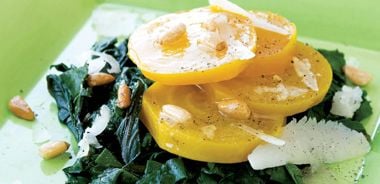Beet Carpaccio on Sautéed Greens

Beets are high in folic acid and potassium and are a good source of vitamins A and C.
4 medium gold coloured beets, crisp greens attached
1/3 cup (80 mL) flaxseed oil
2 Tbsp (30 mL) seasoned rice vinegar
1/2 tsp (2 mL) Dijon mustard
1/4 cup (60 mL) pine nuts, toasted
1 cup (100 g) shaved Manchego cheese
Trim beets, leaving roots intact. Set greens aside. Place in large pot of water and bring to a boil. Reduce heat to medium and gently boil beets until tender but still slightly firm when pierced with a skewer. Drain and cool.
Wash and spin dry leaves. Place in saucepan with a little water and steam just until wilted. Drain well and coarsely chop.
Combine oil, vinegar, and mustard in small bowl and whisk to blend. Drizzle 2 Tbsp (30 mL) over greens and toss to coat. Using tongs, divide into 4 servings and place a mound on each plate.
Peel cooled beets; thinly slice on a mandolin or with a small sharp knife. Divide slices among 4 serving plates, fanning them over beet greens.
Sprinkle with toasted pine nuts and shavings of Manchego cheese. Drizzle with remaining whisked dressing.
Serves 4.
Tip: Manchego substitute
Can’t find Manchego cheese? No problem. You can substitute Pecorino Romano for the Manchego.
Each serving contains:
354 calories; 8 g protein; 32 g total fat (8 g sat. fat, 0 g trans fat); 11 g carbohydrates; 3 g fibre; 225 mg sodium
source: "Winter Veggies", alive #325, November 2009





